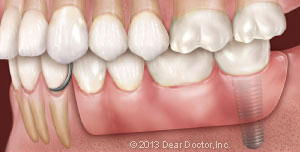Removable Partial Dentures
Still A Viable Tooth-Replacement Alternative
Dear Doctor,
I need to replace some missing teeth, but can't afford dental implants or fixed bridgework. Is there a viable alternative?

Dear Joanna,
The simple answer to your question is yes. Removable partial dentures (RPDs) provide a viable alternative to fixed bridgework or implants as a means of replacing missing teeth. They were quite commonplace before the routine use of implants. However, this answer needs qualification. Certainly in most cases RPDs are much less expensive than either dental implants (today's state-of-the-art tooth replacement systems), or fixed bridgework (the next best alternative). But we need to consider viability not just in terms of expense, but also in regards to function and aesthetics (appearance).
Precision Dentistry
Let me first qualify what I mean by an RPD: A partial denture replaces one or more teeth, as opposed to a full denture, which replaces all the teeth in a jaw. RPDs generally attach to the remaining teeth by means of rests and clasps. It is removable by you; it is not fixed in place in your mouth. It is supported by the gum ridge areas where the teeth once were and, in the case of an upper RPD, the palate (roof of the mouth). Most importantly, it is designed to last for years. I am not describing a transitional type of denture such as a plastic “flipper,” so-called because it can easily be flipped out with the tongue.
RPDs are precision made and usually constructed of vitallium — a lightweight, rigid, strong metal alloy that allows the partial denture to be very thin and unobtrusive, yet conduct sensation. The artificial teeth are made either of porcelain, glass-filled resins or plastics; they are anchored in pink resins or plastics that mimic gingival (gum) tissue. This assembly of artificial teeth and gums is then attached to the vitallium substructure. Small vitallium rests and clasps are designed to grip the teeth rigidly to maintain the stability of the denture, and to minimize deflecting forces of the bite.
The design of precision RPDs is quite critical to their success and will depend upon a number of factors:
- The number of teeth missing that require replacement;
- The location of the teeth and their distribution within the dental arches (upper or lower jaw — which are arch-shaped);
- The health and condition of the remaining teeth.
Rocking And Rolling
The trick in partial denture design is to prevent rocking and movement of the removable dentures during function, and to make them as unobtrusive, aesthetic, and lifelike as possible. This requires an understanding of how the jaws work together, the way the bite functions, and how the remaining teeth can be utilized to stabilize a denture during biting function. This is something of an art; while science can calculate how levers, pivots and fulcrums will work — all essential to partial denture design — these elements in a living system may function differently than on a workbench. RPDs are designed to prevent undue pressure on the bony ridges where teeth are missing, as that tends to accelerate a gradual melting away of bone. RPDs are also designed to minimize pressure and torque on the remaining anchor teeth and their supporting periodontal structures (the gum and bone tissues) in order to preserve them for as long as possible. Upper RPDs tend to be easier to design than lowers because the palate, which does not resorb, can be used to distribute pressure more evenly and easily.
Something Old, Something New
 |
| A dental implant is often added to provide stability and support for a lower partial denture when there is no end tooth in the area. |
Where several teeth are missing on one side with no end tooth on which to rest an RPD (referred to as a “free-end saddle”), or when a large segment of teeth are missing in one section, it can be challenging to design an RPD. Removable dentures in such situations tend to be unstable. A good solution is to place one or two strategic dental implants, which fuse to the bone providing a rigid anchor to improve stability to the RPD. This does not dramatically increase costs, yet significantly improves treatment outcomes.
The Ups And Downs of RPDs
Because of the way RPDs attach to the remaining teeth, they tend to accumulate a lot of bacterial biofilm (plaque), which can lead to an increased incidence of both periodontal (gum) disease and tooth decay. RPDs can also result in teeth becoming loose over time if the RPD's do not fit properly or are unstable during function. Therefore the remaining teeth and gum tissues must be kept scrupulously clean. The dentures, too, must be cleaned thoroughly — a task made easier by their removability. They should not be left in at night and your dentist should check their fit during your office visits.
In sum, excellent daily oral hygiene — which includes brushing, flossing, use of fluoride toothpaste supplemented by mouthrinses, and regular dental checkups — together with scrupulous care of the RPD, are all prerequisites to success with this method of replacing teeth.
On the positive side, in a clean, biofilm-free and healthy mouth, a well-designed, well-made, accurately fitting RPD can provide a very viable aesthetic and functional alternative to more expensive options.




